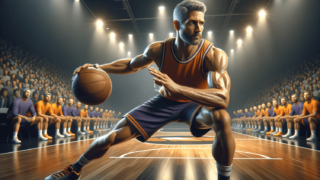
How to Develop a Quick First Step in Basketball?
Written by: Basketball Universe
Last updated:

Welcome to this exciting blog post, where we will delve into the essential world of mastering the quick first step in basketball! For those looking to elevate their game and leave opponents behind, developing a lightning-fast first step is one of the most effective ways to conquer the court. Combining fun and professional guidance, we’ll break down the techniques and conditioning routines that will help you achieve that explosive acceleration. So, make sure to lace up your sneakers and get ready for a thrilling journey as we explore how to improve your speed, agility, and overall performance on the court!
How to Develop a Quick First Step in Basketball?
To develop a quick first step in basketball, focus on improving lower body strength, flexibility, and agility. Incorporate exercises like squats, lunges, and deadlifts to build your leg muscles, while plyometric exercises such as box jumps and power skips will boost your explosiveness. Stretch and perform dynamic warm-ups to enhance flexibility, and practice first step drills like the jab step or V-cut on the court. It’s also essential to train your reaction time and sharpen your mental game for optimal results.
Building Lower Body Strength
Strong and powerful legs are the foundation of a quick first step in basketball. To develop a strong base, focus on exercises that target your quadriceps, hamstrings, glutes, and calves. Here are some top exercises to incorporate into your workout routine:
Squats
Squats are a versatile exercise that helps build strength and improve stability in your lower body. Start by performing basic bodyweight squats, then progress to adding weights, such as dumbbells or a barbell, to increase the resistance and challenge. For greater specificity, try single-leg squats to mimic the unilateral nature of the first step in basketball.
Lunges
Like squats, lunges target multiple lower body muscles and can be easily progressed over time. Begin with bodyweight walking lunges, then gradually add weights or try different variations, such as reverse lunges and lateral lunges, to further challenge your balance and stability.
Deadlifts
Deadlifts are essential for developing the muscles in your posterior chain, promoting a more efficient and explosive first step. Start with conventional deadlifts to develop a strong foundation, and then experiment with variations like the Romanian or sumo deadlift to target specific muscle groups and improve your overall lower body strength.
Enhancing Explosiveness with Plyometrics
Plyometrics are high-intensity, explosive exercises designed to improve your power, speed, and ability to react quickly. By incorporating plyometric exercises into your training routine, you can develop the explosiveness needed for a lightning-fast first step in basketball. Some great plyometric exercises to consider include:
Box Jumps
Box jumps are a simple yet effective exercise that trains your explosive power and lower body strength. Stand in front of a sturdy box, jump onto it using both feet and then jump back down. This exercise can be easily scaled by adjusting the height of the box or adding weight vests to increase the challenge.
Power Skips
Power skips are an excellent way to improve your vertical leap and first-step quickness. Focus on using your arms to generate momentum and pushing through your toes to achieve maximum height and distance with each skip. Perform multiple sets and aim to increase the power and height of your skips over time.
Depth Jumps
Depth jumps are a more advanced plyometric exercise that helps improve the reactive strength and explosiveness needed for a quick first step. To perform a depth jump, stand on an elevated surface, step off and immediately jump as high as possible upon landing. Emphasize minimizing the time spent on the ground to enhance your reactive ability.
Focusing on Flexibility
Improving your flexibility will not only aid your first step quickness but also help prevent injuries. Incorporate dynamic stretching into your warm-up routine, targeting muscles like your hip flexors, quadriceps, hamstrings, and calves. Consider adding static stretching and yoga to your cool-down routine to further improve your flexibility and promote recovery.
Dynamic Warm-Up Exercises
Dynamic warm-up exercises help activate and lengthen muscles, preparing them for high-intensity activities like basketball. Moves such as leg swings, high knees, and walking lunges will help improve your range of motion and enhance your first step explosiveness on the court.
Static Stretching
Static stretching helps maintain and increase muscle flexibility, which promotes better movement efficiency and may reduce injury risk. Hold each stretch for around 15-30 seconds and focus on the muscle groups used most in basketball. For example, stretch your glutes, hamstrings, quadriceps, and calves.
Yoga
Practicing yoga can provide a myriad of benefits for basketball players, from improving flexibility to enhancing focus and mental toughness. Incorporating regular yoga sessions into your training routine can be an effective way to increase your range of motion and improve your first step on the court.
Agility and First Step Drills
To translate your newfound strength, explosiveness, and flexibility into a quick first step in basketball, spend time practicing specific drills and exercises on the court. These drills help develop acceleration, body control, and the ability to change direction quickly.
Jab Step Drill
The jab step is a fundamental basketball move that helps create space between you and your defender. Begin by standing with your feet shoulder-width apart and the ball in triple-threat position. Take a quick step to the side, stay low and balanced, and then return to your starting position. Remember to practice both sides, and increase the speed of the jab as you become more comfortable with the movement.
V-Cut Drill
The V-Cut drill helps train your first step acceleration while cutting on the court. Start by setting up two markers, such as cones, in a V-shape, with the wide end facing your imaginary defender. Sprint forward from the wide end, change directions at the narrow end, and sprint back to the starting position. Be sure to practice both directions, focusing on exploding out of the turn and accelerating back to the starting position.
Reaction and Speed Drills
Improving your reaction time will help you initiate a quicker first step during a basketball game. Use reaction drills, like partner mirrors or response drills, to enhance your ability to quickly start and stop. Additionally, incorporate speed workouts, such as hill sprints and resisted sprints, to develop your overall sprinting ability.
Mental Preparation and Basketball IQ
Physical improvement is just one aspect of developing a quick first step in basketball. It’s equally important to sharpen your mental game to predict and react efficiently to the game’s situations. Engage in film study, work with a coach or mentor to develop a better understanding of the game, and remember that experience is key to success. Building your basketball IQ and refining your mental approach to the game will only enhance your first step capabilities on the court.
Film Study
Studying film can provide valuable insights into both your performance and the tendencies of your opponents. Watch game footage to study offensive and defensive patterns, identify areas for improvement, and develop strategies for exploiting weaknesses in your competition.
Mentorship
Working with a coach, trainer, or mentor who understands the game can give you invaluable knowledge and guidance. They can help you tailor your training, provide feedback on your technique, and help you develop the mental toughness required to excel on the court.
Remember, developing a quick first step in basketball requires a combination of physical and mental preparation. By focusing on building strength, explosiveness, flexibility, and agility, while sharpening your mental game, you’ll be well on your way to dominating the court and leaving defenders in the dust!
Nutrition and Recovery
Maintaining a balanced diet and focusing on recovery are essential components of developing a quick first step in basketball. Proper nutrition fuels your body for optimal performance during training sessions and games, while adequate recovery helps repair your body and build stronger muscles. Let’s take a closer look at the importance of nutrition and recovery in your training routine:
Proper Nutrition
Eating a well-rounded diet that contains a mix of carbohydrates, proteins, and fats ensures your body receives the necessary energy and nutrients for peak performance. Emphasize whole, nutrient-dense foods like fruits, vegetables, lean proteins, and whole grains to fuel your workouts and support muscle growth. Stay hydrated throughout the day and during training sessions, as dehydration can affect your ability to accelerate and change direction on the court.
Recovery Techniques
Implementing effective recovery techniques can enhance your progress by facilitating muscle repair and growth. Consider these recovery methods to support your overall performance and improvement:
- Rest Days: Schedule regular rest days into your training routine to allow your body time to repair and recover. Overtraining can increase the risk of injury and decrease overall performance.
- Sleep: Getting adequate sleep is crucial for proper muscle recovery and mental focus. Aim for 7-9 hours of quality sleep each night to support your training and performance goals.
- Foam Rolling: Foam rolling or self-myofascial release can reduce muscle soreness, improve flexibility, and enhance recovery. Focus on your lower body muscles, such as your quadriceps, hamstrings, calves, and glutes, spending about a minute on each area.
Monitoring Progress and Setting Goals
It’s important to track your progress and set goals as you work on developing a quick first step in basketball. Regular assessments and goal-setting can provide motivation, focus your training efforts, and help identify any areas that require further development. Consider these tips for monitoring progress and setting goals:
Benchmark Testing
Assessing your baseline strength, speed, and agility will help you measure improvement over time. Perform tests like the vertical jump, 40-yard sprint, and shuttle run to establish your starting point and re-test periodically to track your progress.
SMART Goals
Setting SMART (Specific, Measurable, Achievable, Relevant, Time-based) goals will help you stay on track and keep your training efforts focused. For example, you might set a goal like “Increase my vertical jump by 2 inches in 8 weeks” or “Improve my 40-yard sprint time by 0.2 seconds in 6 weeks.” Having clear, achievable targets will give you direction and motivation throughout your training journey.
Adjusting Training as Needed
As your progress, your training needs and goals may change. Be prepared to adjust your workouts, incorporate new exercises, or tweak your training plan based on your most recent assessments and goals. Continual adaptation will ensure that you’re always pushing yourself and moving closer to that elusive, lightning-fast first step.
As you strive to develop a quick first step in basketball, remember the importance of a comprehensive approach encompassing physical and mental training, nutrition and recovery, and monitoring progress and goal-setting. With dedication, focus, and a well-rounded program, you can unlock your potential and become a quicker and more explosive athlete on the court.
Frequently Asked Questions
In this FAQ section, we address some common questions related to developing a quick first step in basketball. These concise answers will help further your understanding and provide you with helpful tips and guidance that you can apply to your own training routine.
1. How long does it take to see improvements in my first step?
The time it takes to see improvements in your first step will vary depending on factors like your current fitness level, commitment to training, and overall genetics. With consistent effort, most individuals can expect to see noticeable improvements after several weeks or months of targeted training.
2. Can I develop a quick first step without access to a gym?
Yes, you can still develop a quick first step without access to a gym. Focus on bodyweight exercises and plyometrics that target the lower body, as well as on-court drills, flexibility training, and basketball IQ development through film study and mentorship.
3. How often should I train to improve my first step?
A good starting point is to train 3-4 times per week, incorporating a combination of strength training, plyometrics, agility drills, and flexibility exercises. Remember to also prioritize rest and recovery to avoid overtraining.
4. How important is reaction time in developing a quick first step in basketball?
Reaction time plays a crucial role in getting a jump on your defender and capitalizing on scoring opportunities. Improving your reaction time through specific drills and exercises will contribute significantly to the development of a fast first step.
5. What role does flexibility play in developing a quick first step?
Flexibility is essential for a quick first step, as it enables you to move efficiently, maintain a proper range of motion, and prevent injuries. Incorporating stretching and flexibility exercises into your routine will support your overall athleticism and first-step quickness.
6. How can I integrate first-step training into my current basketball training regimen?
To integrate first-step training into your current basketball regimen, incorporate lower-body strength training exercises, plyometrics, and agility drills into your workouts. Additionally, focus on flexibility and reaction time exercises to support your overall performance on the court.
On-court drills are crucial for practicing your first step in a game-like environment. However, incorporating additional exercises such as strength training, plyometrics, and flexibility exercises will help augment your overall athleticism and significantly improve your first step.
Choose basketball shoes that provide good ankle support, a secure fit, and ample cushioning. Look for lightweight shoes with good traction for optimal acceleration and agility during first step training.
Genetics can influence factors like muscle fiber composition, which may affect your natural speed and ability to develop a quick first step. However, with proper training and commitment, most individuals can significantly improve their first step quickness regardless of their genetic predisposition.
To measure your progress, perform periodic assessments of your strength, speed, and agility using tests like the vertical jump, 40-yard sprint, and shuttle run. Compare your results over time to track improvements and adjust your training plan as needed.
Featured Posts
- No pillar pages found.





